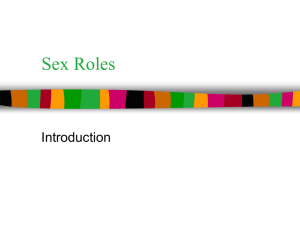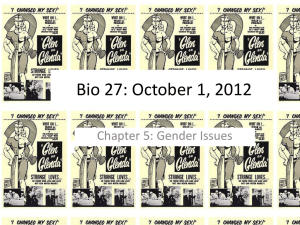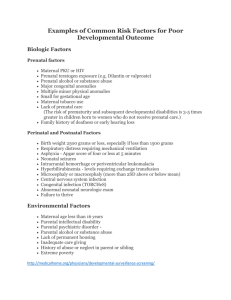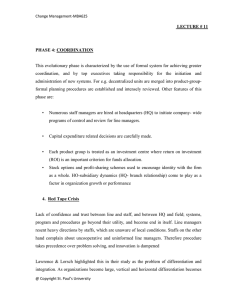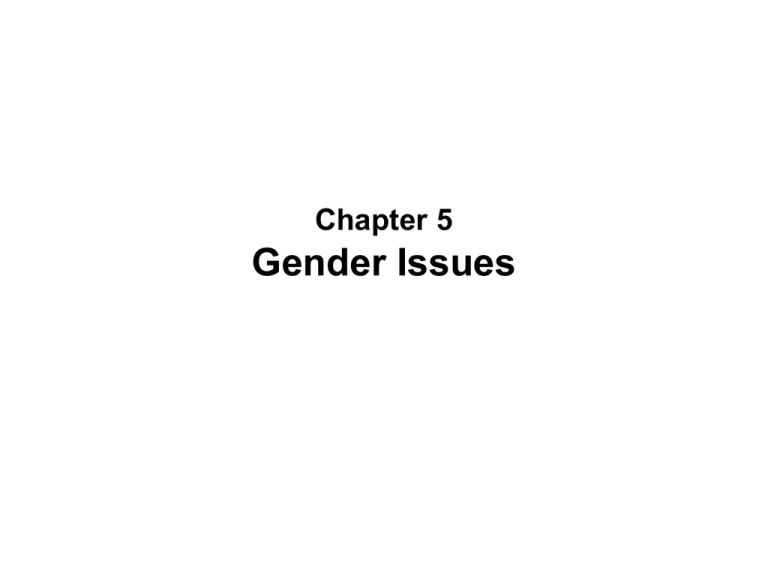
Chapter 5
Gender Issues
Sex and Gender
Definitions
• Sex
– genetic, anatomical
• Gender
– psychosocial meaning of maleness and femaleness
• Gender Identity
– subjective sense of being male or female
• Gender (Sex) Role
– cultural norms for male and female behavior
Gender-Identity Formation
• Typical prenatal differentiation
– 23 human chromosomes
• 22 autosomes and 1 sex chromosome
– Chromosomal sex
• XX: female
– DSS gene on X
– SRY gene on Y
XY: male
Typical Prenatal Differentiation
Typical Prenatal Differentiation
• Gonadal sex
– Ovaries or testes
• Hormonal sex
– Estrogens and androgens
Typical Prenatal Differentiation
• Internal structures
– Müllerian duct
• Males – Vas deferens, seminal vesicles, ejaculatory duct
– Wolffian duct
• Females – Fallopian tubes, uterus, inner 1/3 vagina
• External structures
– Genital tubercle
• Clitoris or penis
– Labioscrotal swelling
• Labia or scrotum
Prenatal Differentiation of Internal
Structures
Prenatal Differentiation of External
Genitals
Homologous Sex Organs
Sex Differentiation Of The Brain
• Hypothalamus
– Differentiates in pregnancy
– Directs production of sex hormones
– May influence sex differences and sexual functioning
• Cerebral hemispheres
• Corpus callosum
Parts of the Brain
Atypical Prenatal Differentiation
• Intersexed
– True hermaphrodites
– Pseudohermaphrodites
• Sex chromosome disorders
– Turner’s syndrome XO
– Klinefelter’s syndrome
XXY
Atypical Prenatal Differentiation
• Disorders affecting prenatal hormonal processes
– Androgen insensitivity syndrome (AIS)
– Fetally androgenized females
– DHT-deficient males
Atypical Prenatal Differentiation
Social Learning Influences on Gender
Identity
• Firm gender identity by age 3
• Mead study
– Culture determines gender role
• Long-term case studies by Money
– Psychosexually neutral at birth
• Follow-up of Money’s cases by Diamond
• Another case often overlooked (Bradley)
• Long-term problems with surgical reassignment
The Interactional Model
• Nature
– Biological determinants
• Nurture
– Social learning and the environment
• Acknowledge the interaction of both
• Relative roles are still unclear
Transsexualism and Transgenderism
• Transexualism
– Gender identity is opposite to biological sex
• Transgendered
– Appearance and/or behavior does not conform to
traditional gender roles
– Variations of transgendered behaviors
• Intersexed people
• Gender Identity vs. sexual orientation
Transsexualism
• Etiology
• Options
– Gender blending/cross-dressing
– Psychotherapy
– Sex reassignment
• Outcomes
Gender Roles
• Gender-based stereotypes (North American)
– Males
• Independent and aggressive
– Females
• Dependent and submissive
• Recent trend away from rigid stereotypes
– Women less entrenched than men in rigid gender-role
stereotypes
• Ethnic variation in gender roles
Gender Roles
Agents of Socialization
•
•
•
•
•
Parental expectations
Peers
School teachers and textbooks
Television and gender-based stereotypes
Religious training
Gender Role Expectations
•
•
•
•
•
Women undersexed, men oversexed
Men initiate, women receive
Women as controllers, men as movers
Men are unemotional and strong
Women are nurturing and supportive
Androgyny
Transcending Gender Roles
• Having characteristics of both sexes
• Benefits
• Drawbacks
• May show more flexibility and comfort with
sexuality

